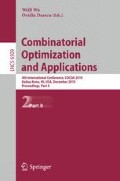Abstract
Given a graph G = (V,E) in which a fugitive hides on vertices or along edges, graph searching problems are usually to find the minimum number of searchers required to capture the fugitive. In this paper, we consider the problem of finding the minimum number of steps to capture the fugitive. We introduce the fast edge-searching problem in the edge search model, which is the problem of finding the minimum number of steps (called the fast edge-search time) to capture the fugitive. We establish relations between the fast edge-search time and the fast search number. While the family of graphs whose fast search number is at most k is not minor-closed for any positive integer k ≥ 2, we show that the family of graphs whose fast edge-search time is at most k is minor-closed. We establish relations between the fast (edge-)searching and the node searching. These relations allow us to transform the problem of computing node search numbers to the problem of computing fast edge-search time or fast search numbers. Using these relations, we prove that the problem of deciding, given a graph G and an integer k, whether the fast (edge-)search number of G is less than or equal to k is NP-complete; and it remains NP-complete for Eulerian graphs. We also prove that the problem of determining whether the fast (edge-)search number of G is a half of the number of odd vertices in G is NP-complete; and it remains NP-complete for planar graphs with maximum degree 4. We present a linear time approximation algorithm for the fast edge-search time that always delivers solutions of at most \((1+\frac{|V|-1}{|E|+1})\) times the optimal value. This algorithm also gives us a tight upper bound on the fast search number of the graph. We also show a lower bound on the fast search number using the minimum degree and the number of odd vertices.
Access this chapter
Tax calculation will be finalised at checkout
Purchases are for personal use only
Preview
Unable to display preview. Download preview PDF.
References
Alon, N., Pralat, P., Wormald, R.: Cleaning regular graphs with brushes. SIAM Journal on Discrete Mathematics 23, 233–250 (2008)
Alspach, B., Dyer, D., Hanson, D., Yang, B.: Lower bounds on edge searching. In: Chen, B., Paterson, M., Zhang, G. (eds.) ESCAPE 2007. LNCS, vol. 4614, pp. 516–527. Springer, Heidelberg (2007)
Biedl, T., Chan, T., Ganjali, Y., Hajiaghayi, M.T., Wood, D.: Balanced vertex-ordering of graphs. Discrete Applied Mathematics 148, 27–48 (2005)
Bonato, A., Golovach, P., Hahn, G., Kratochvíl, J.: The capture time of a graph. Discrete Mathematics 309, 5588–5595 (2009)
Dereniowski, D., Diner, Ö., Dyer, D.: Three-fast-searchable graphs (manuscript)
Dyer, D., Yang, B., Yaşar, Ö.: On the fast searching problem. In: Fleischer, R., Xu, J. (eds.) AAIM 2008. LNCS, vol. 5034, pp. 143–154. Springer, Heidelberg (2008)
Kára, J., Kratochvíl, J., Wood, D.: On the complexity of the balanced vertex ordering problem. Discrete Mathematics and Theoretical Computer Science 9, 193–202 (2007)
Kirousis, L., Papadimitriou, C.: Searching and pebbling. Theoretical Computer Science 47, 205–218 (1986)
Messinger, M.E., Nowakowski, R.J., Pralat, P.: Cleaning a network with brushes. Theoretical Computer Science 399, 191–205 (2008)
Megiddo, N., Hakimi, S., Garey, M., Johnson, D., Papadimitriou, C.: The complexity of searching a graph. Journal of ACM 35, 18–44 (1988)
Stanley, D., Yang, B.: Lower bounds on fast searching and their applications. In: Dong, Y., Du, D.-Z., Ibarra, O. (eds.) ISAAC 2009. LNCS, vol. 5878, pp. 964–973. Springer, Heidelberg (2009)
Author information
Authors and Affiliations
Editor information
Editors and Affiliations
Rights and permissions
Copyright information
© 2010 Springer-Verlag Berlin Heidelberg
About this paper
Cite this paper
Yang, B. (2010). Fast Edge-Searching and Related Problems. In: Wu, W., Daescu, O. (eds) Combinatorial Optimization and Applications. COCOA 2010. Lecture Notes in Computer Science, vol 6509. Springer, Berlin, Heidelberg. https://doi.org/10.1007/978-3-642-17461-2_19
Download citation
DOI: https://doi.org/10.1007/978-3-642-17461-2_19
Publisher Name: Springer, Berlin, Heidelberg
Print ISBN: 978-3-642-17460-5
Online ISBN: 978-3-642-17461-2
eBook Packages: Computer ScienceComputer Science (R0)

